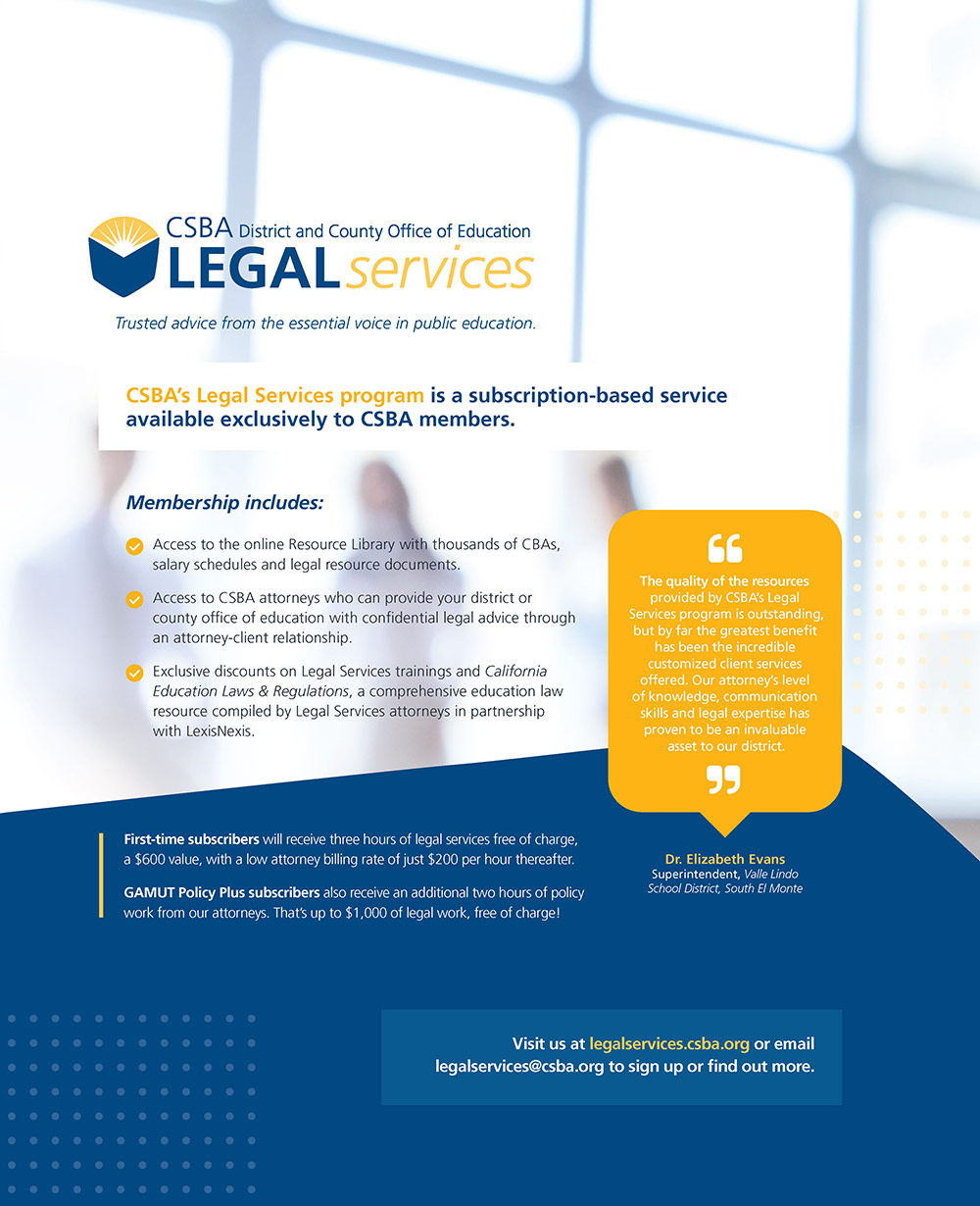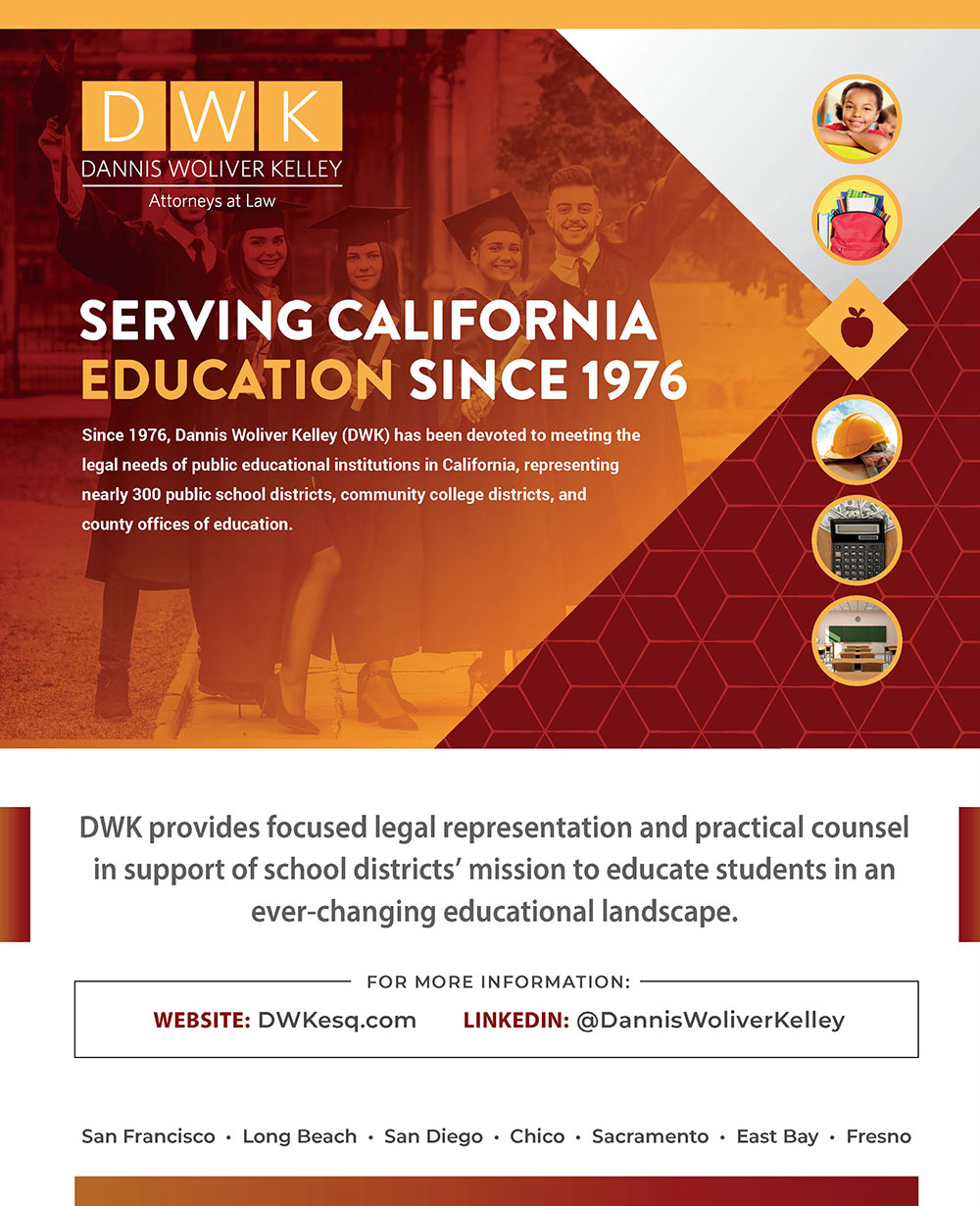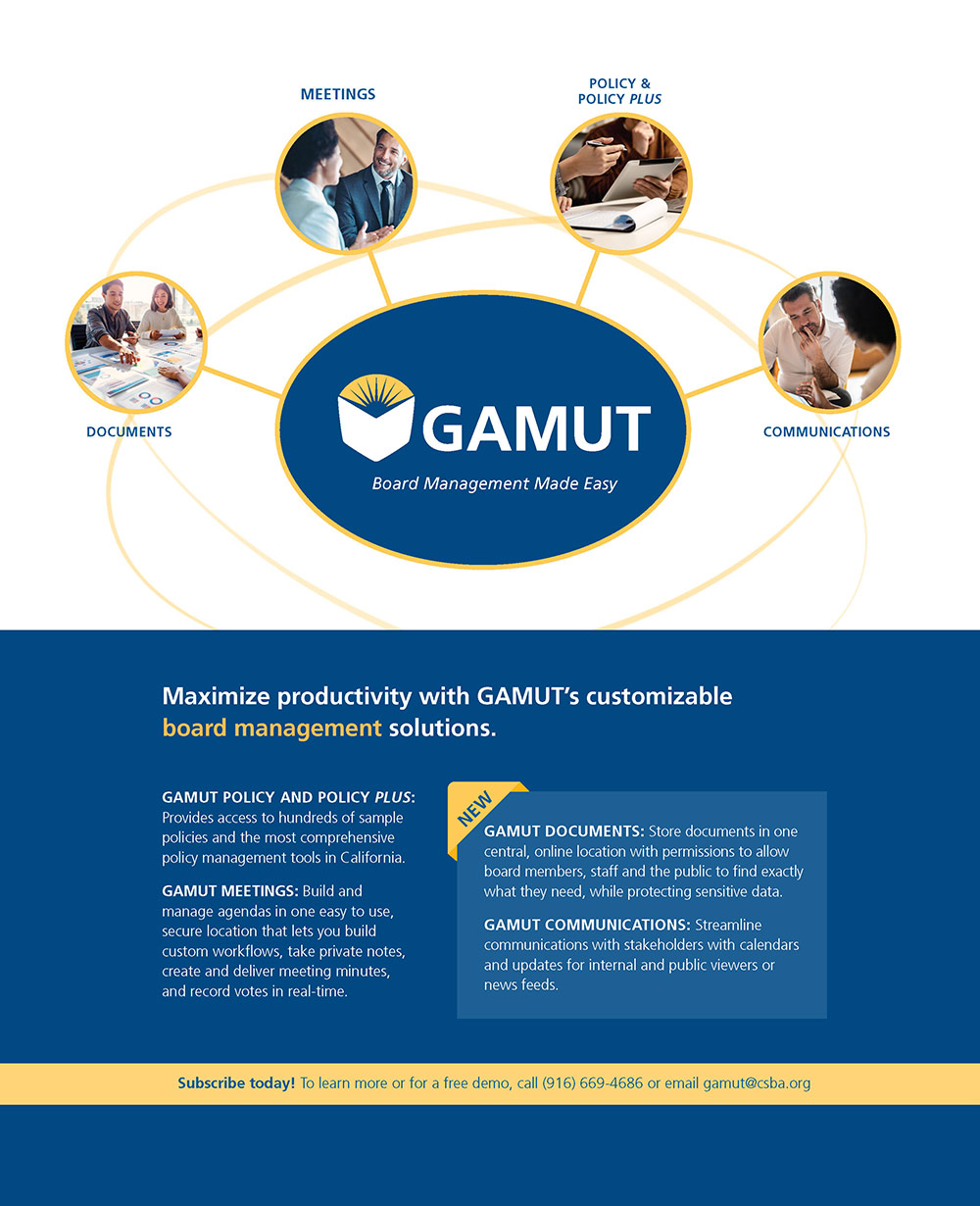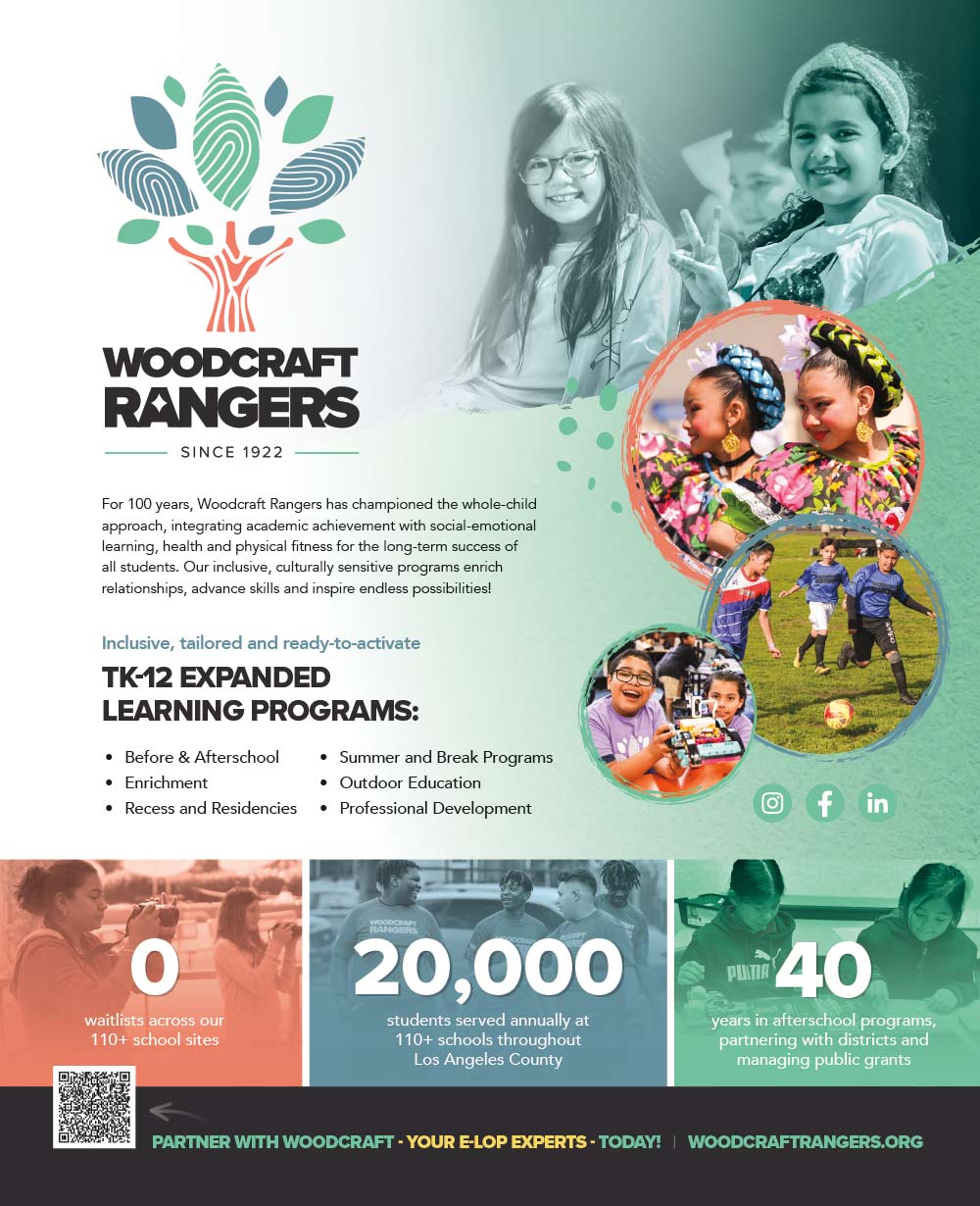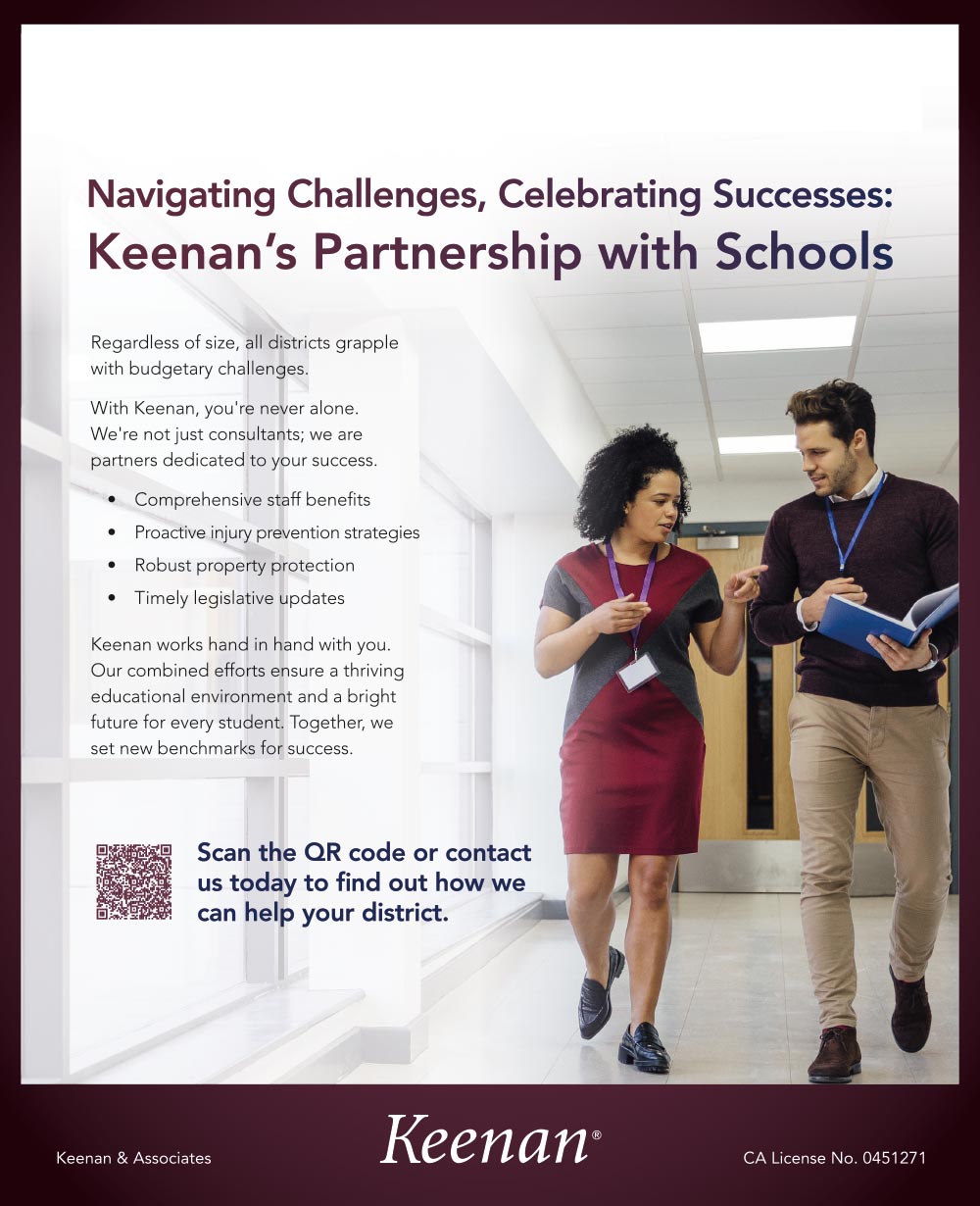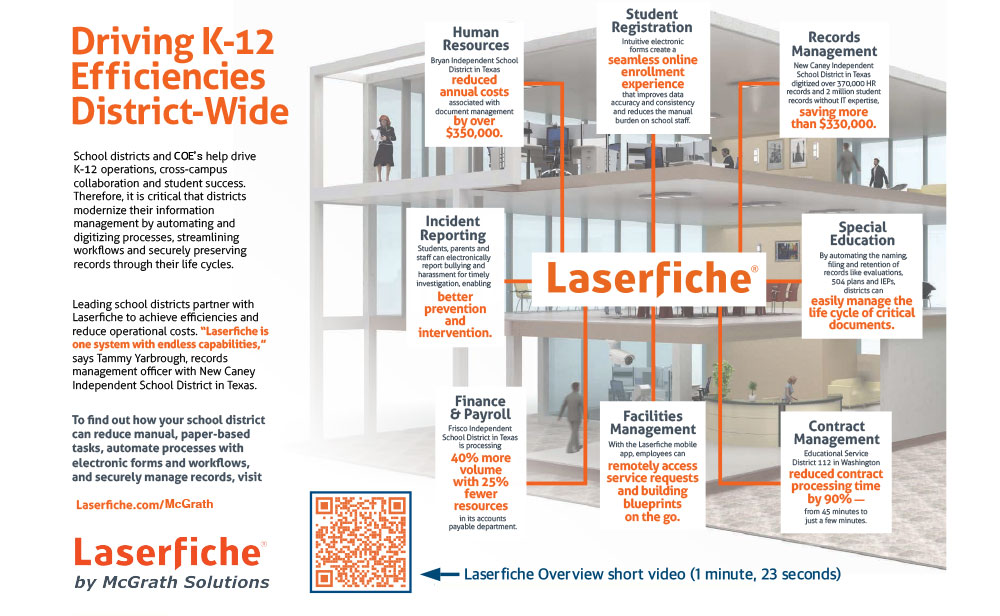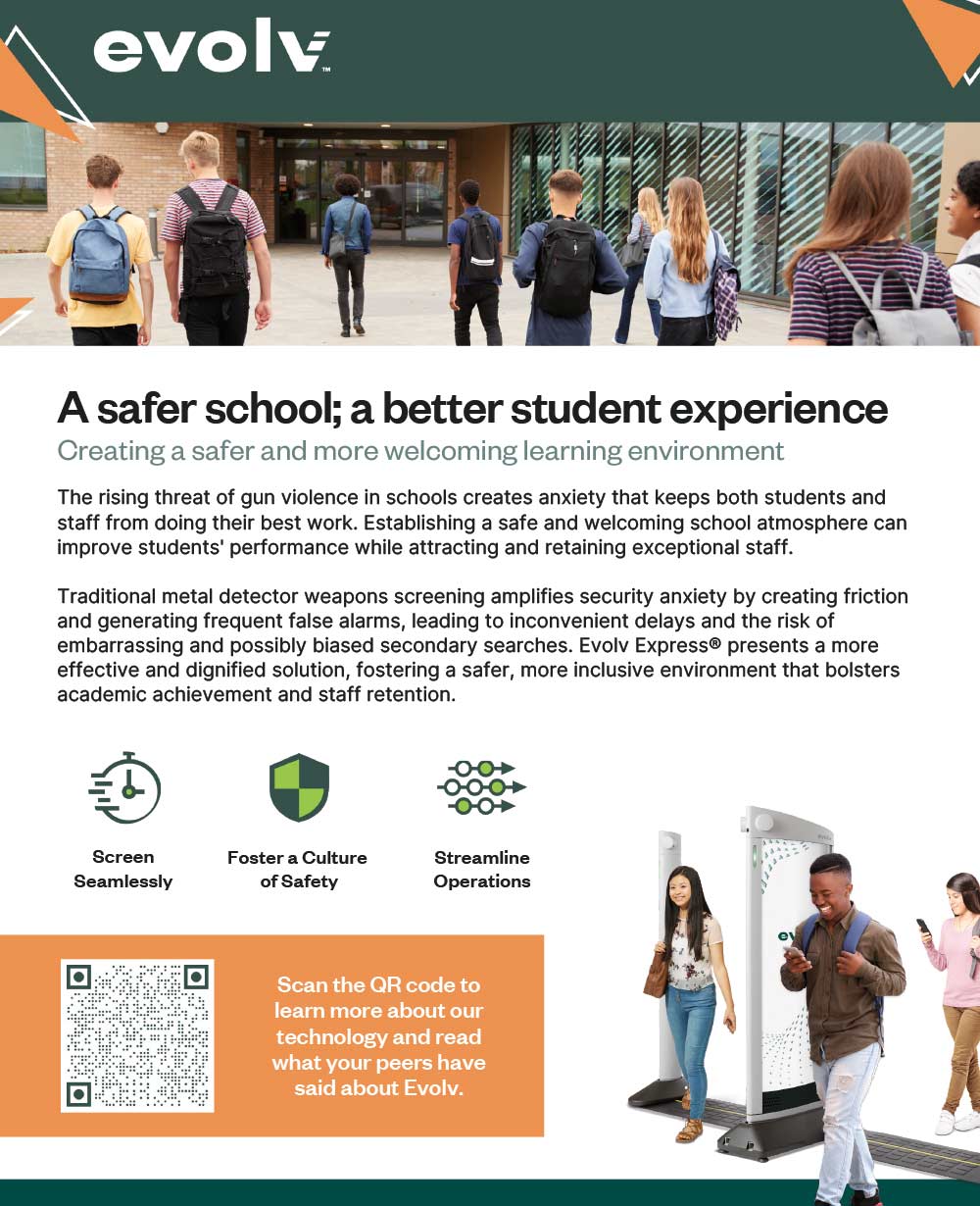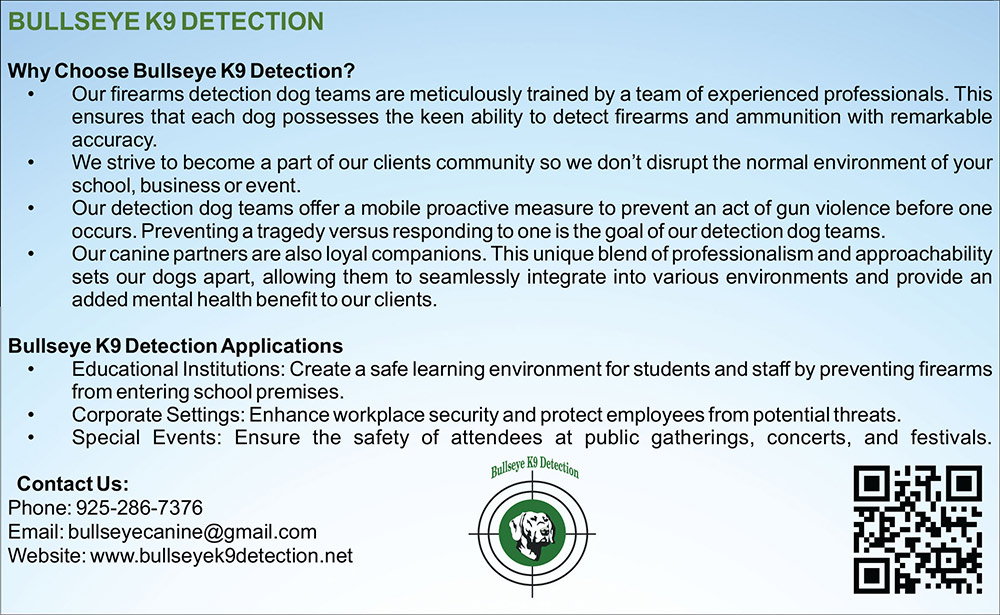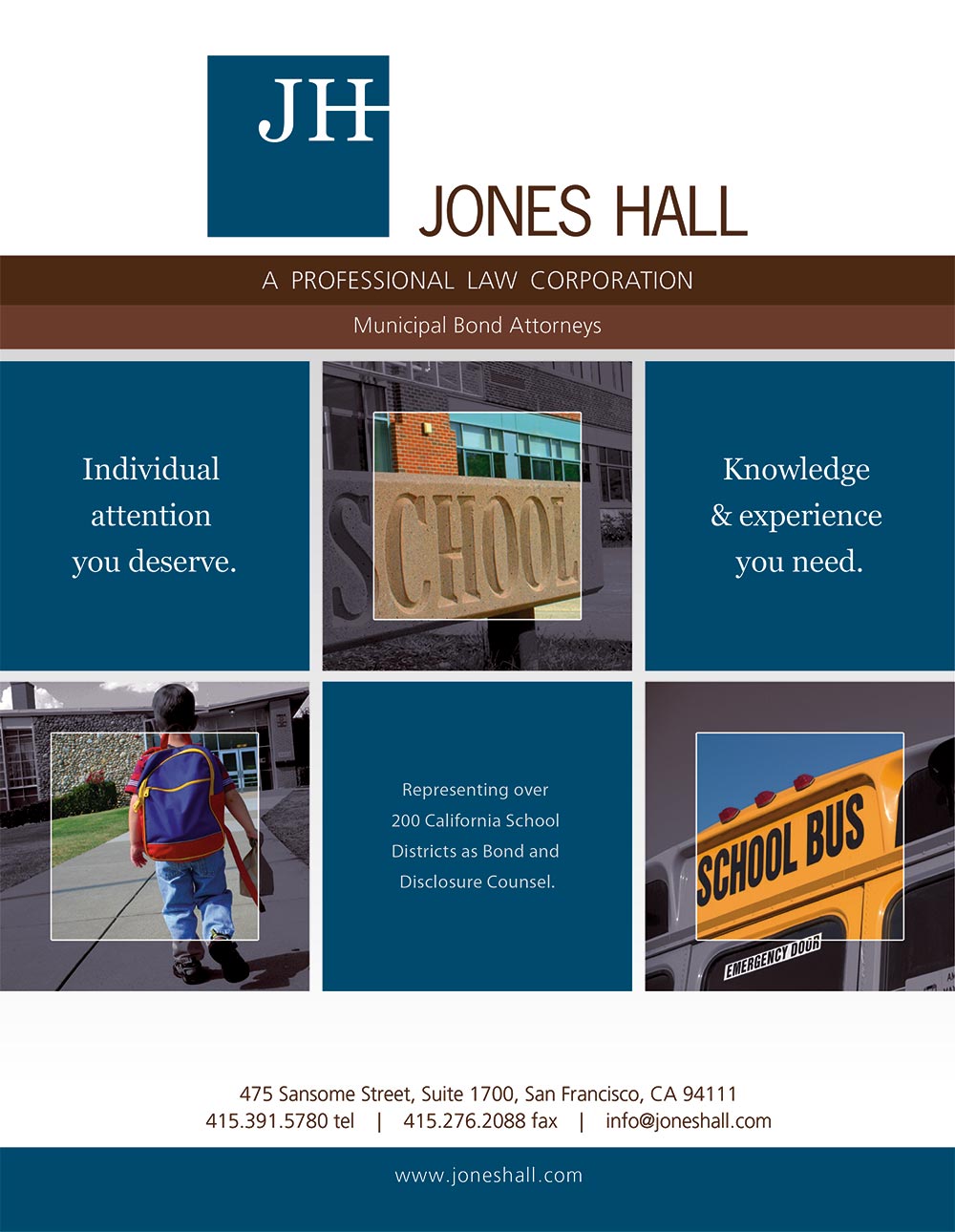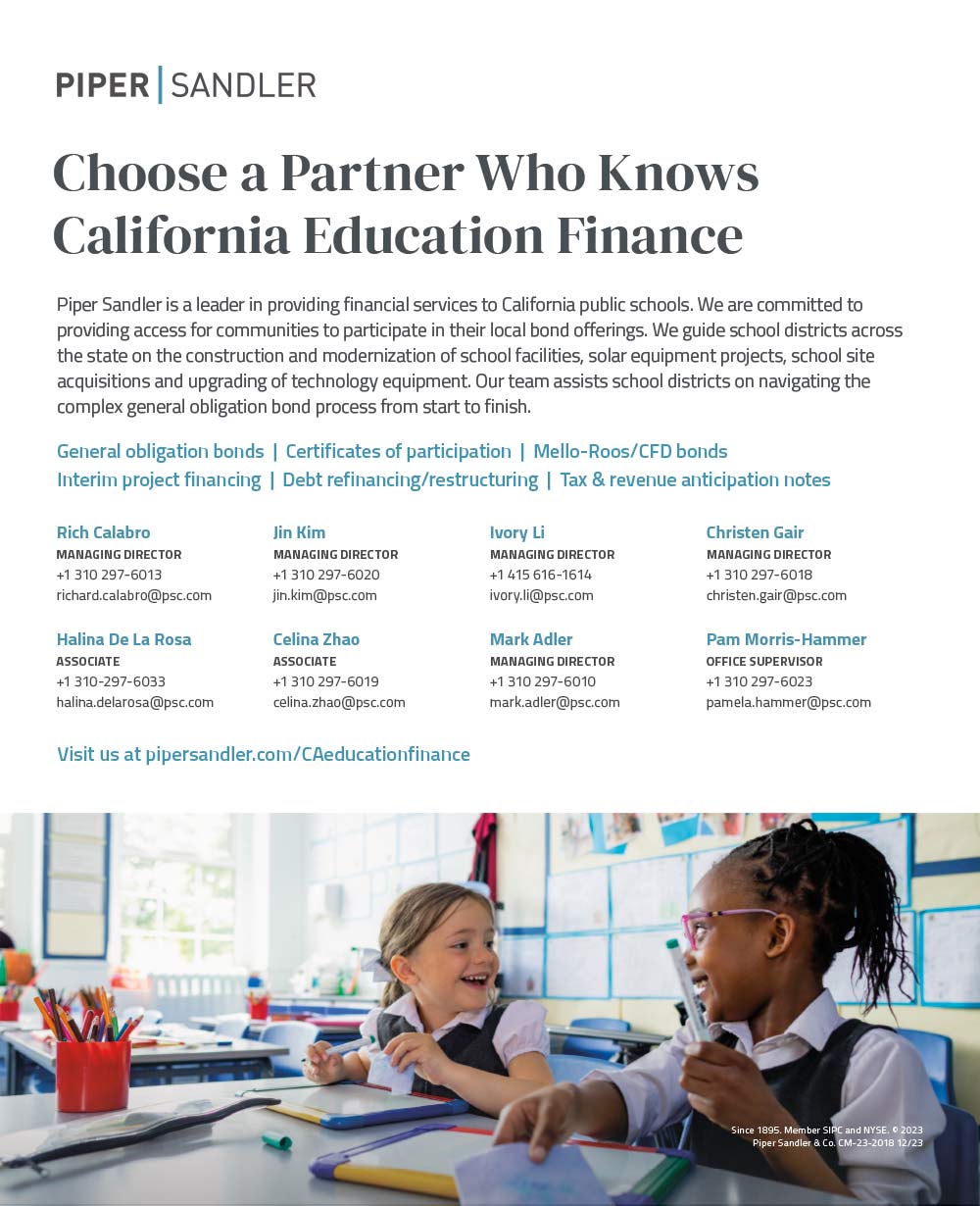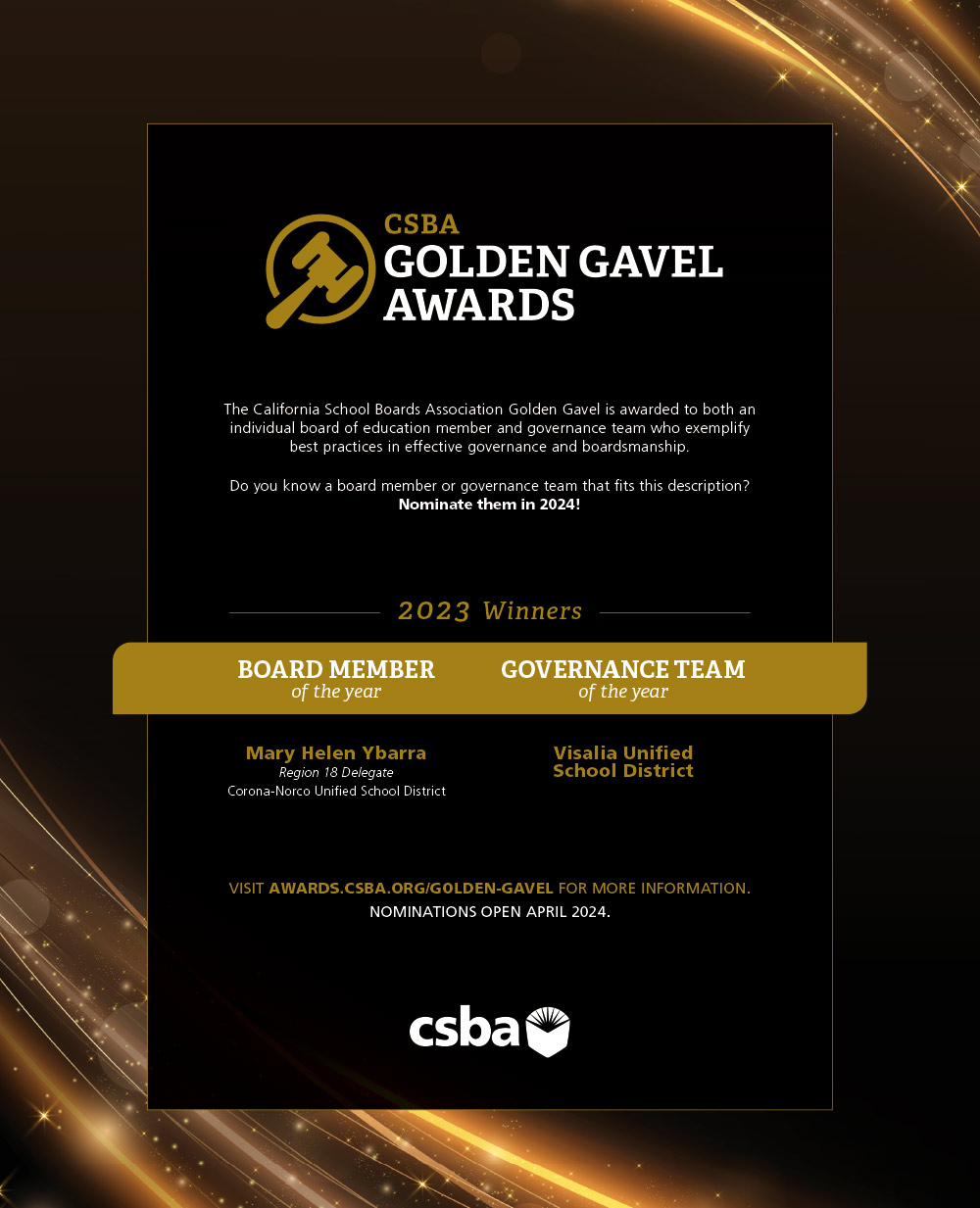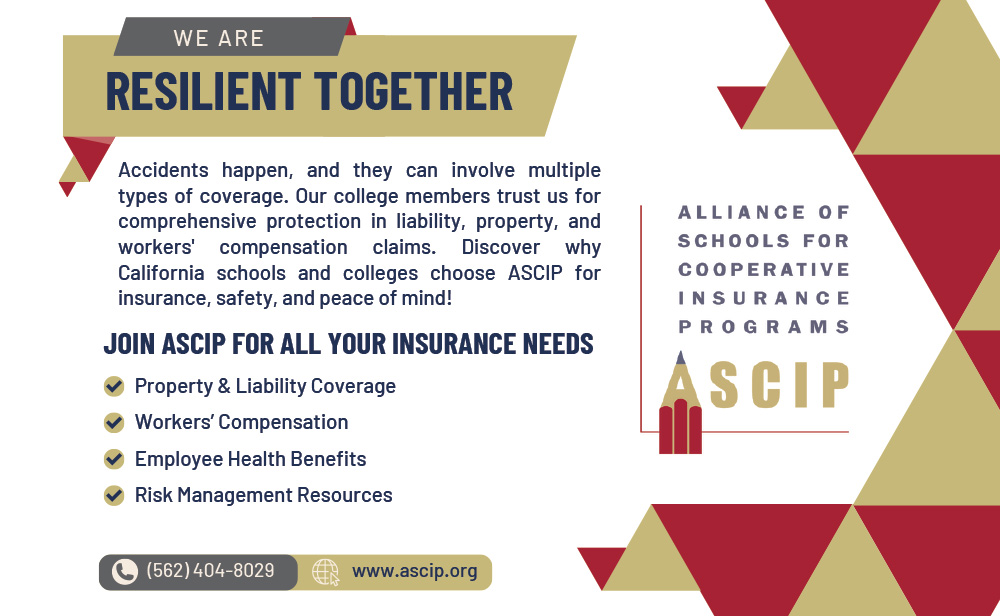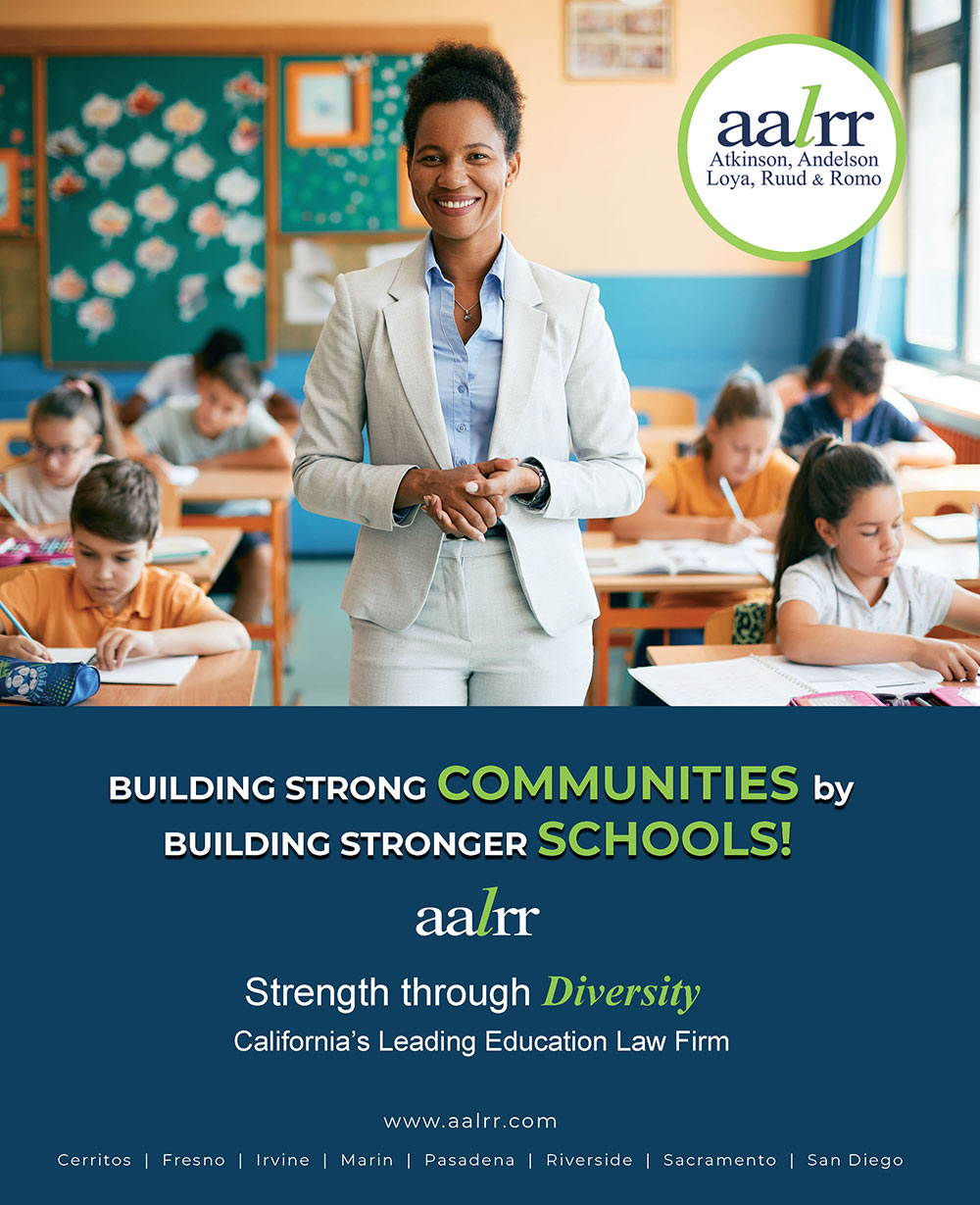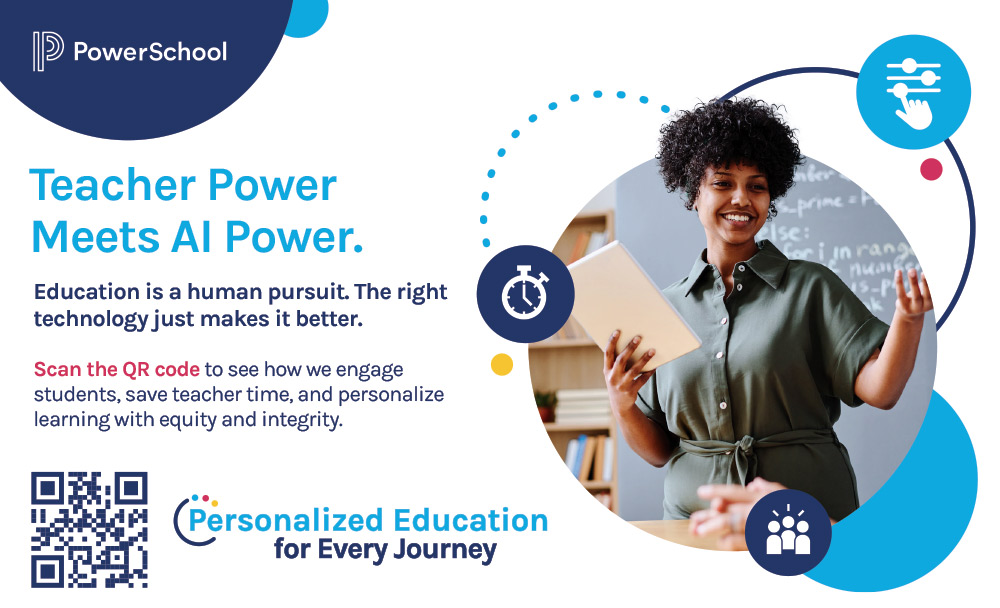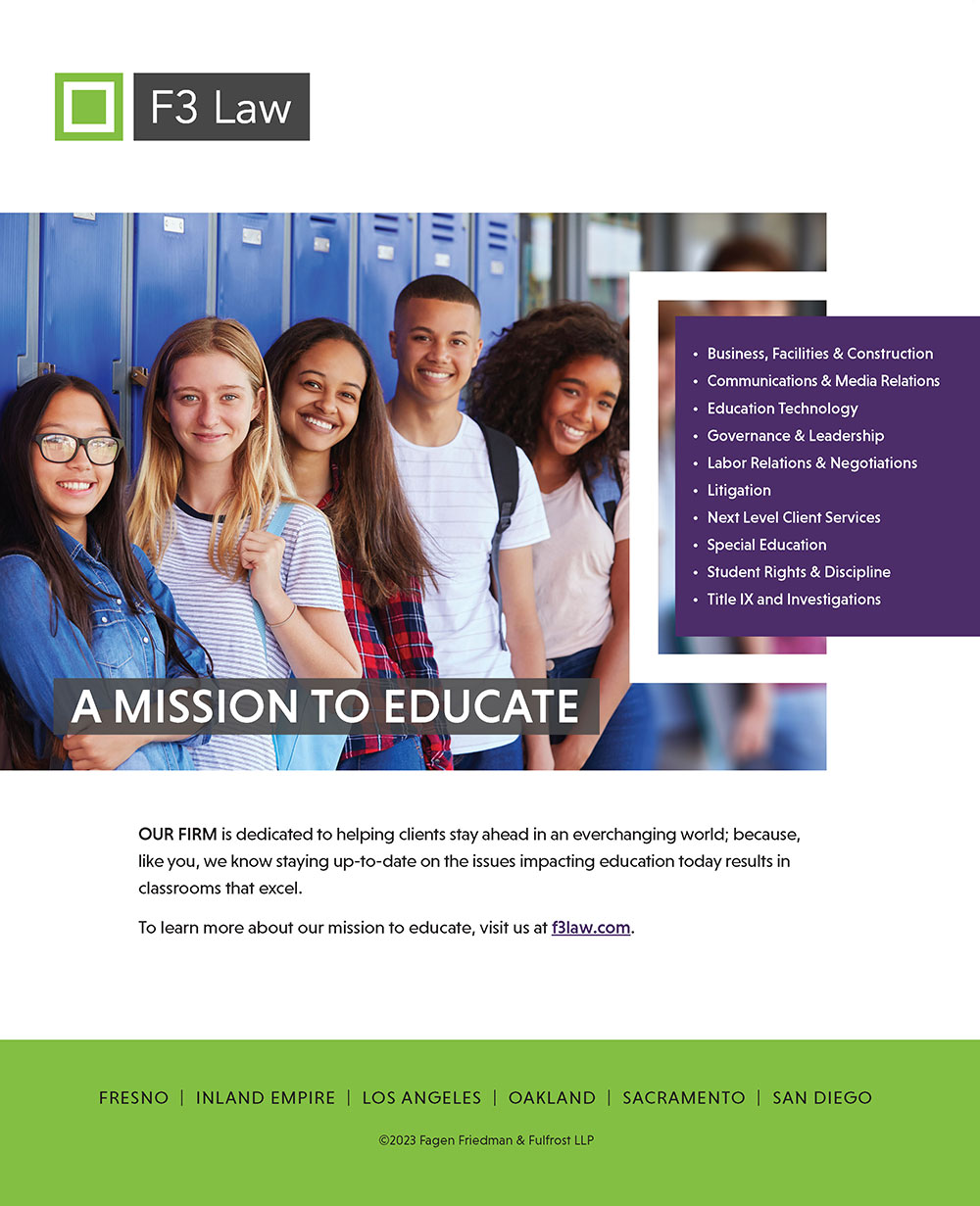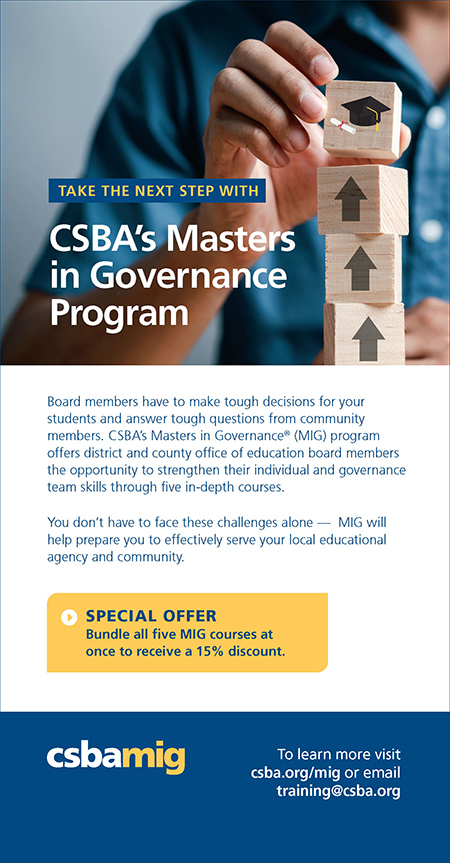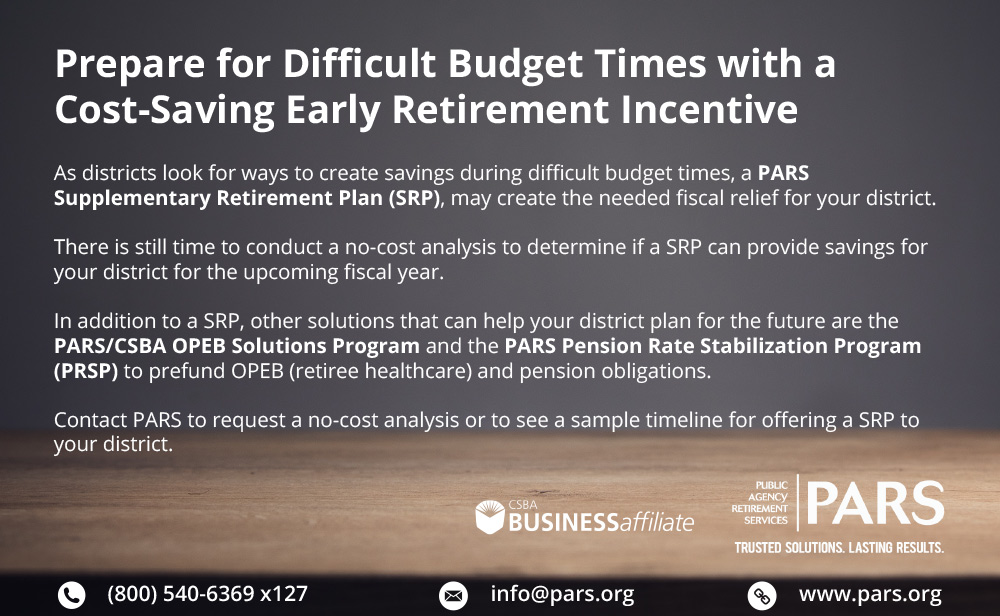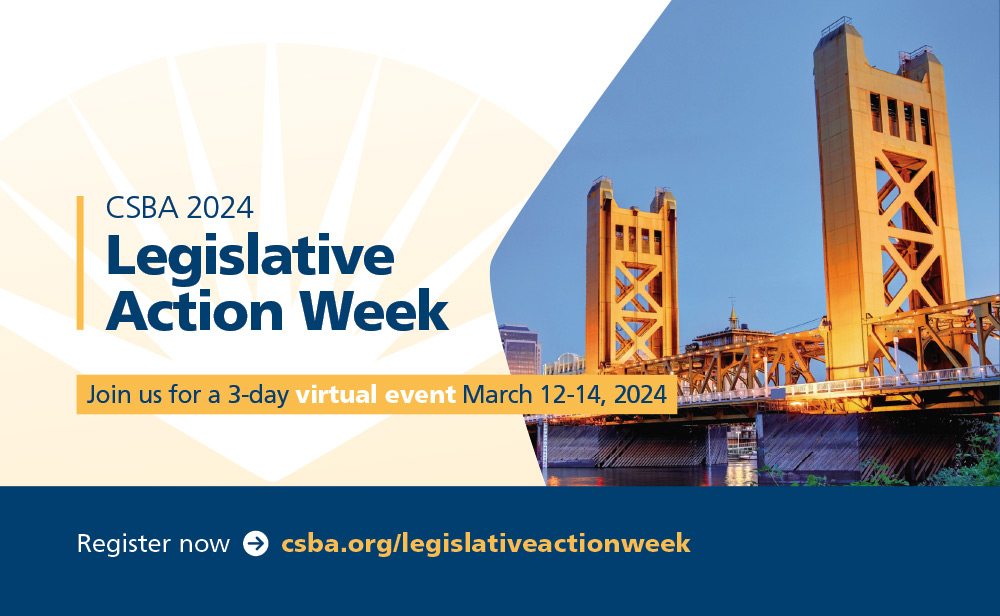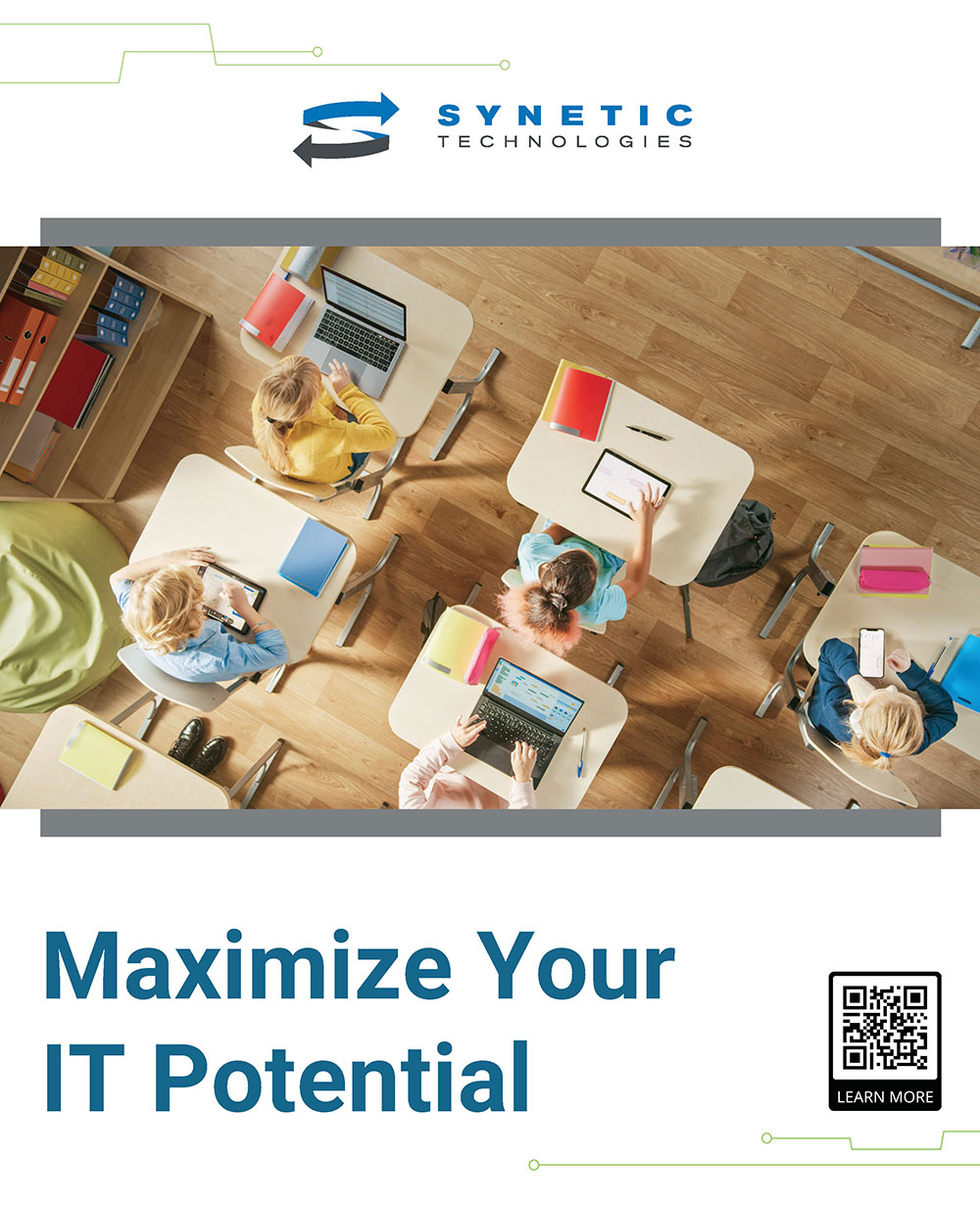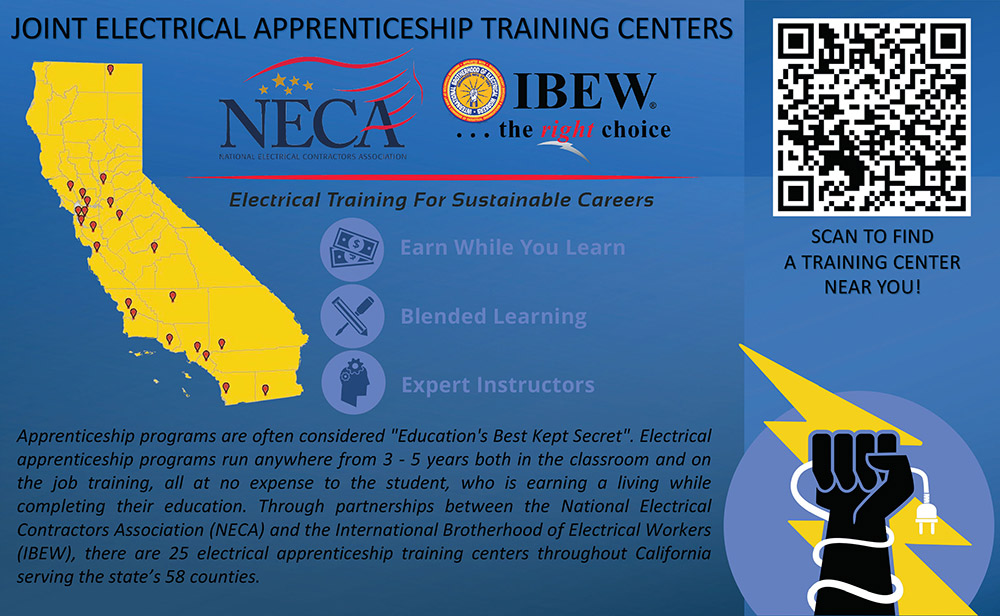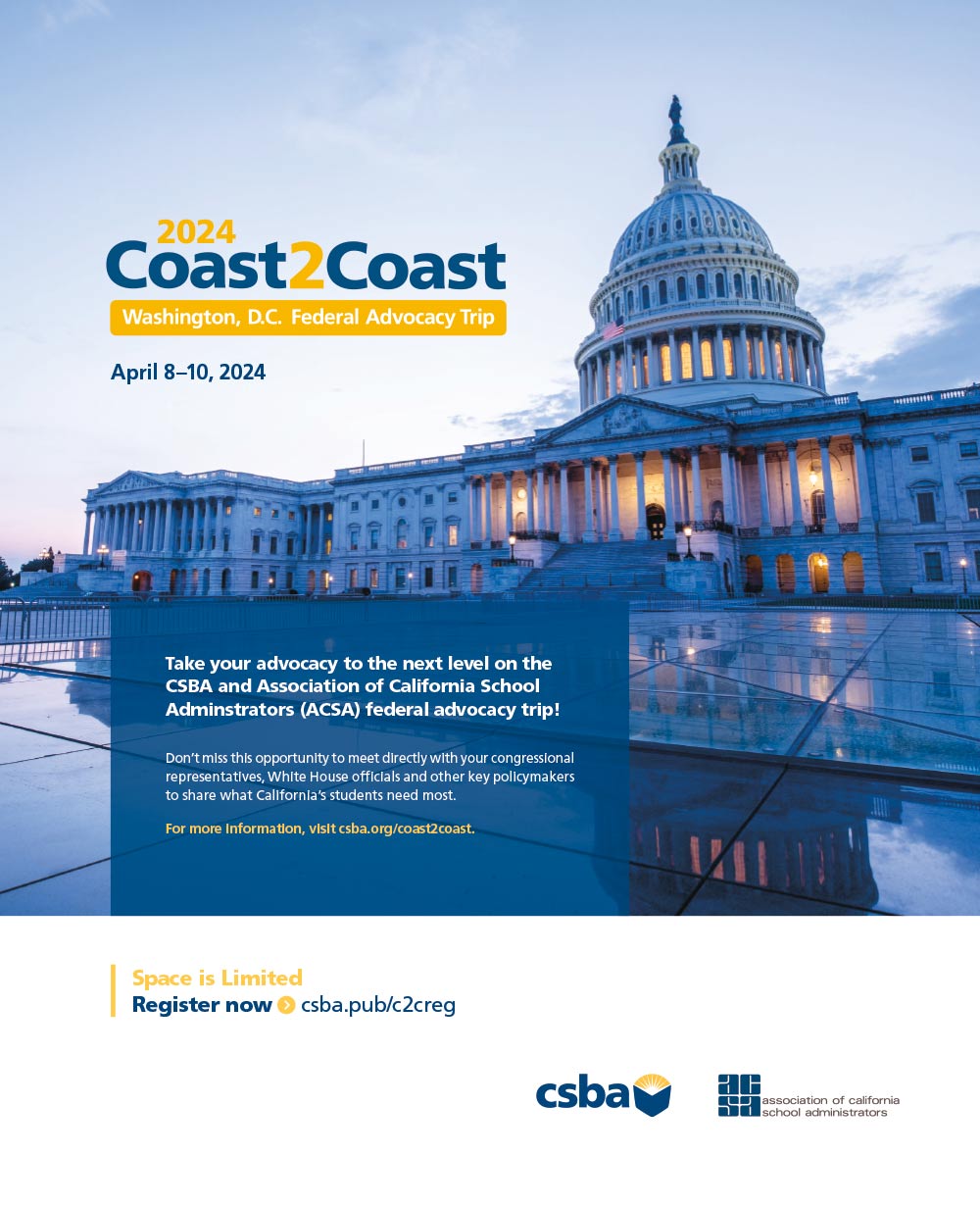

Bridging
the gap
How career technical education unites job training and academics

Winter 2024
The California School Boards Association is the essential voice for public education. We inspire our members to be knowledgeable leaders, extraordinary governance practitioners and ardent advocates for all students.
How career technical education unites job training and academics
by Kimberly Sellery
School closure guidance and best practices for LEAs
by Heather Kemp
LEAs strive to help this growing population succeed in school and life
by Alisha Kirby
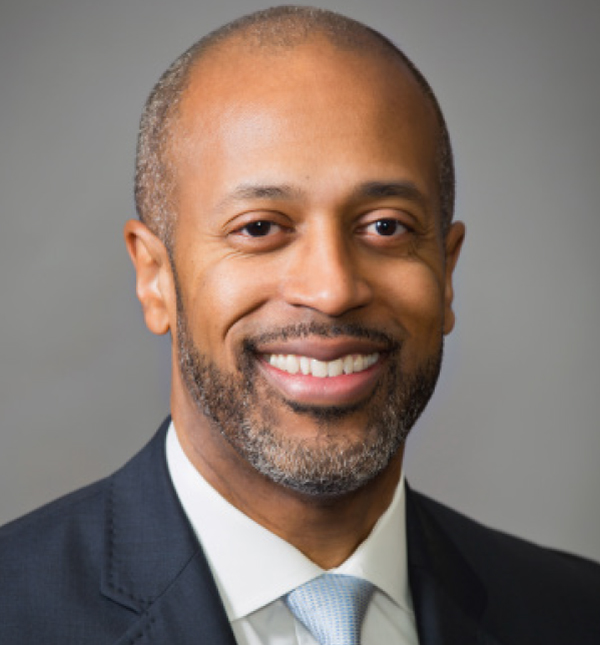
CEO’s note
n 1979, California voters passed Proposition 4, requiring the state to reimburse local governments for the cost of new programs and higher levels of service it imposes upon them. This state constitutional mandate, enshrined in Article XIII B, section 6, applies to all local governments such as school districts, cities and counties, with some exceptions, including when the state suspends a mandate.

The number of state reimbursable education mandates varies based on the number of new laws enacted that require a mandate. For simplicity, let’s say historically the number of reimbursable education mandates has hovered somewhere between 30 to 40, with the suspension of about a dozen additional K-12 mandates at times.
To be clear, this unfunded mandate problem is not limited to local educational agencies. In fact, about two decades ago, the League of California Cities and other local government organizations representing cities and counties drafted and successfully secured voter approval of Proposition 1A. This ballot initiative, among other things, attempted to limit the state’s excessive approach to imposing new mandates onto cities, counties and special districts without providing funding to implement them. The success of the initiative is debatable, but for a moment in time, their effort not only brought greater awareness to the serious impact of unfunded mandates on local governments, but it also had a chilling effect — albeit a brief one — in the halls of the state Capitol.

Region 1, Del Norte County USD
Region 2
Region 3, Napa Valley USD
Region 4, Eureka Union SD
Region 5, Redwood City ESD
Region 6, Washington USD
Region 7, San Leandro USD
Region 8, Ripon USD
Roger Snyder
Region 9, Scotts Valley USD
Region 10, Caruthers USD
Region 11, Ventura USD
Region 12, Sierra Sands USD
Region 15, Huntington Beach Union HSD
Region 16, Silver Valley USD
Region 17, Oceanside USD
Region 18, Riverside COE
Region 20, Mountain View Whisman SD
Tanya Ortiz Franklin
Region 21, Los Angeles USD
Region 22, Palmdale SD
Region 23, Walnut Valley USD
Region 24, South Whittier ESD
Director-at-Large African American, Folsom-Cordova USD
Director-at-Large American Indian, Needles USD
Director-at-Large Asian/Pacific Islander, Cupertino Union SD
Director-at-Large County, Ventura COE
Joaquín Rivera
Director-at-Large Hispanic, Alameda COE
Region 1, Del Norte County USD
Region 2
Region 3, Napa Valley USD
Region 4, Eureka Union SD
Region 5, Redwood City ESD
Region 6, Washington USD
Region 7, San Leandro USD
Region 8, Ripon USD
Region 9, Scotts Valley USD
Region 10, Caruthers USD
Region 11, Ventura USD
Region 12, Sierra Sands USD
Region 15, Huntington Beach Union HSD
Region 16, Silver Valley USD
Region 17, Oceanside USD
Region 18, Riverside COE
Region 20, Mountain View Whisman SD
Tanya Ortiz Franklin
Region 21, Los Angeles USD
Region 22, Palmdale SD
Region 23, Walnut Valley USD
Region 24, South Whittier ESD
Director-at-Large African American, Folsom-Cordova USD
Director-at-Large American Indian, Needles USD
Director-at-Large Asian/Pacific Islander, Cupertino Union SD
Director-at-Large County, Ventura COE
Joaquín Rivera
Director-at-Large Hispanic, Alameda COE
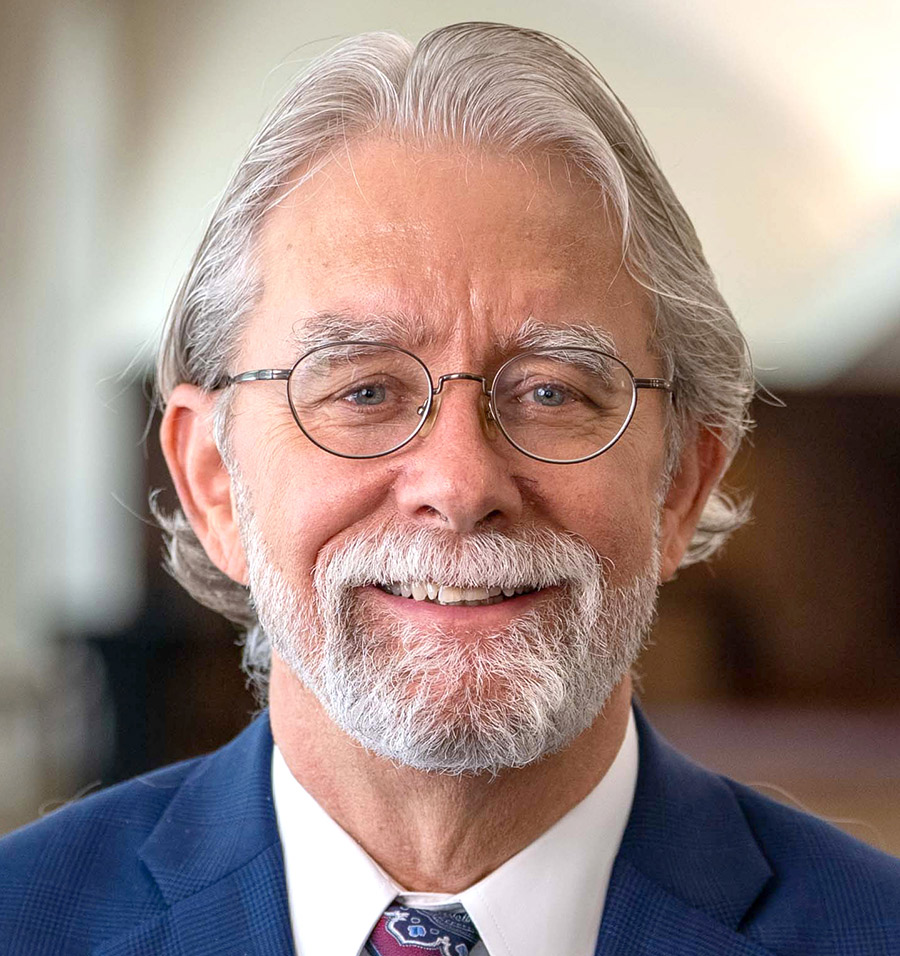
legal insights
A reflection on a year — and a career
he start of a new year seems like a good time to look back at 2023 and take stock of the trends and education issues that defined the year and set the policy and legal stage for 2024.
Boards of education were active and engaged with their communities, exercising their statutory obligation to govern their schools and ensure every student received a free public education.
While districts and county offices of education had to contend with a long list of important issues, there were a few that made headlines or consumed the attention of the majority of districts and county offices of education. There was no shortage of so-called culture wars playing out at local board meetings. Double digit raises for school employees came to an end and searches for students missing from attendance rolls were ongoing. Teachers sought affordable housing and districts and county offices of education sought after teachers and bus drivers to fill their local needs. What could be read by students and what could be taught by teachers became even more of an issue in California and across the nation. And at governing board meetings, discord between boards and members of the public and among board members themselves rose to concerning levels.

Chief Information Officer
Troy Flint, tflint@csba.org
Editorial Director
Kimberly Sellery, ksellery@csba.org
Staff Writers
Heather Kemp, hkemp@csba.org
Alisha Kirby, akirby@csba.org
Director of Graphic Design and Branding
Kerry Macklin, kmacklin@csba.org
Senior Graphic Designer
Amanda Moen, amoen@csba.org
Circulation and Advertising
csba@csba.org
Albert Gonzalez, Santa Clara USD
President-elect
Bettye Lusk, Monterey Peninsula USD
Vice President
Debra Schade, Solana Beach SD
Immediate Past President
Susan Markarian, Pacific Union ESD
CEO & Executive Director
Vernon M. Billy
California Schools (ISSN 1081-8936) is published quarterly by the California School Boards Association, Inc., 3251 Beacon Boulevard, West Sacramento, CA 95691, (916) 371-4691. $2 of CSBA membership dues goes toward the subscription to California Schools magazine for each board member and superintendent. The subscription rate for each CSBA nonmember is $20. Periodicals postage paid at West Sacramento, CA and at additional mailing office. Postmaster: Send address changes to California Schools, 3251 Beacon Blvd., West Sacramento, CA 95691.
Articles submitted to California Schools are edited for style, content and space prior to publication. Views expressed are those of the authors and do not necessarily represent CSBA policies or positions. Articles may not be reproduced without written permission of the publisher. Endorsement by CSBA of products and services advertised in California Schools is not implied or expressed.

class act Best practices in action
Best practices in action

class act
Best practices in action

Student tutors see super results
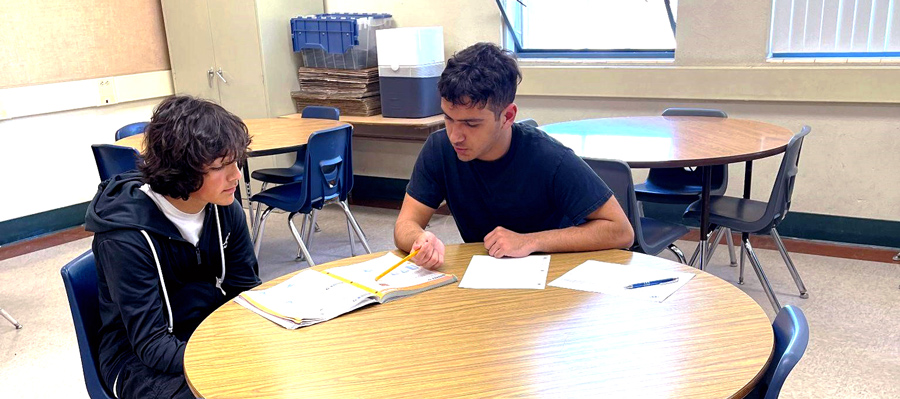
What started as a classroom program to help high school students catch up to grade level in math has multiplied into a districtwide system where students are paid to tutor their peers in a variety of subject areas.
Glendale Unified School District’s Golden Bell Award-winning Super Tutor program was created by Stepan Mekhitarian, the district’s director of Innovation, Instruction, Assessment and Accountability, when he worked as a teacher. Mekhitarian offered additional academic support to students during periods like office hours, but with large groups seeking help, he decided to recruit peer tutors who had content mastery and provide them training on how to deliver effective instruction.
Mekhitarian eventually took on his current role at the district and began working to expand the program beginning with a small number of high schools in 2019.
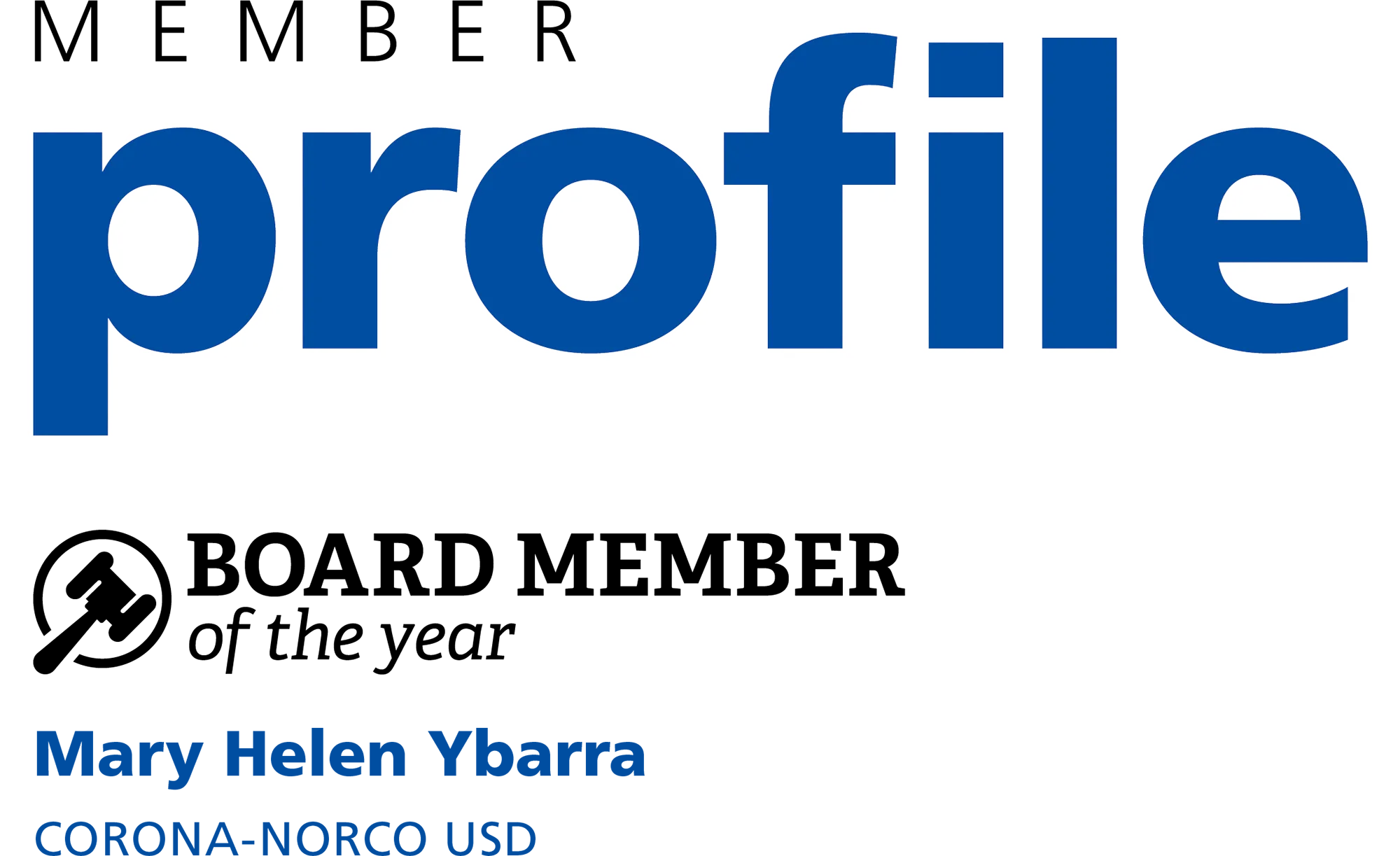
I have been on the board for 10 years. I was inspired to run by hearing teachers and community members in my trustee area who felt that they were not represented. Demographics of the area relate to the culture and experiences of being English learners — there was a lack of representation and now my community feels they are heard, I am their voice. I became the first Latina on the board, a responsibility I do not take lightly. Our district is 52 percent Latino and there was not a Latina on the board. I love visiting schools, attending school events and mostly interacting with my students. The students motivate me.
I feel being involved adds to my knowledge. I want to know how I can continue to support the students in my school district, and I share the information with my board so, together, we can support our school district. CSBA gives us first-hand information on bills as they come down the pipeline, which helps me when speaking to my superintendent in sharing with him what we need to be ready for.
Student voice is a critical factor in the decision-making process for a public school system. During my tenure as board president, I was instrumental in advocating for the student representation on the dais through our student board member program. I also regularly convey my desire to ensure that the district has systems in place to incorporate student voice in our processes. This practice ensures that students remain our primary focus. We have a committee called the Interdistrict Student Committee where we listen to student voice from all our high schools. We value student voice and ensure it is heard.
I am very proud of several accomplishments. One is increasing our CTE medical pathways utilizing industry-standard, state-of-the-art equipment in our high schools so our students can practice. We have an aviation pathway where students taking the class for four years are eligible to take the exam, once they are 21, to become a pilot. I advocated to add Mandarin to our dual immersion program. We now have Mandarin at two elementary schools and a long waiting list to get in.
My advice for aspiring board members is to first find a seasoned board member and sit down for a long talk, ask lots of questions, research the work the board has done in the past. Truly understand what is involved in the job. Get involved! I started with PTA and being on School Site Council in my children’s school. You are going to be making decisions that will impact the lives of thousands of students and staff and ultimately affect your community. Sometimes the community thinks we only go to meetings twice a month, they don’t understand all that we do behind the scenes. It’s constant reading, researching legislation and getting legal opinions, we must engage with the community, staff and students. People do not realize often our hands are tied due to decisions sent down to us via legislative statures. Being a board member requires a lot of commitment and heart for the job even during times of adversity. We learned so much during the pandemic, which proved to be a challenging yet educational time.
Would you like to participate in an upcoming Member Profile? Contact us at editor@csba.org.

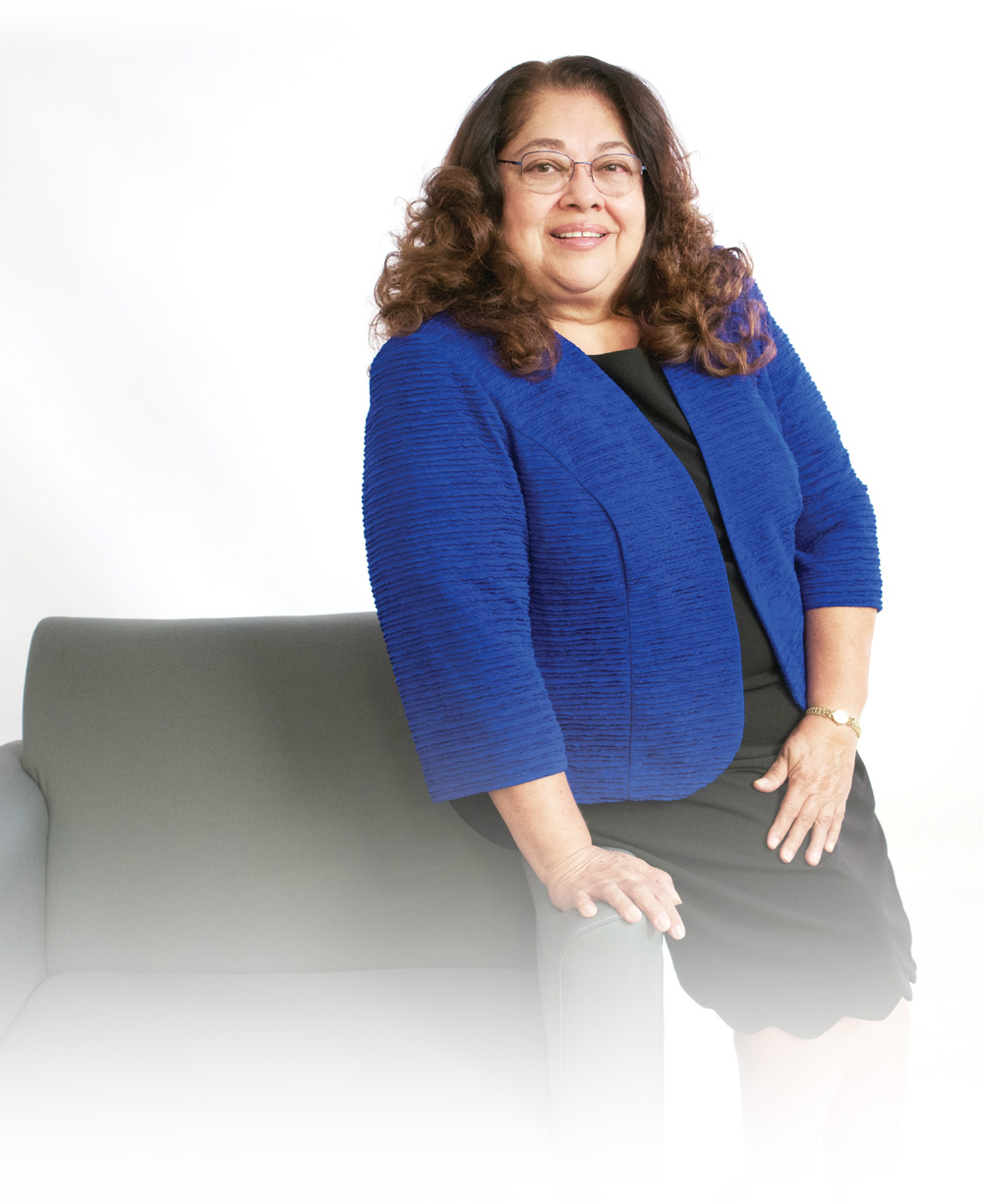
I have been on the board for 10 years. I was inspired to run by hearing teachers and community members in my trustee area who felt that they were not represented. Demographics of the area relate to the culture and experiences of being English learners — there was a lack of representation and now my community feels they are heard, I am their voice. I became the first Latina on the board, a responsibility I do not take lightly. Our district is 52 percent Latino and there was not a Latina on the board. I love visiting schools, attending school events and mostly interacting with my students. The students motivate me.
I feel being involved adds to my knowledge. I want to know how I can continue to support the students in my school district, and I share the information with my board so, together, we can support our school district. CSBA gives us first-hand information on bills as they come down the pipeline, which helps me when speaking to my superintendent in sharing with him what we need to be ready for.
Student voice is a critical factor in the decision-making process for a public school system. During my tenure as board president, I was instrumental in advocating for the student representation on the dais through our student board member program. I also regularly convey my desire to ensure that the district has systems in place to incorporate student voice in our processes. This practice ensures that students remain our primary focus. We have a committee called the Interdistrict Student Committee where we listen to student voice from all our high schools. We value student voice and ensure it is heard.
I am very proud of several accomplishments. One is increasing our CTE medical pathways utilizing industry-standard, state-of-the-art equipment in our high schools so our students can practice. We have an aviation pathway where students taking the class for four years are eligible to take the exam, once they are 21, to become a pilot. I advocated to add Mandarin to our dual immersion program. We now have Mandarin at two elementary schools and a long waiting list to get in.
My advice for aspiring board members is to first find a seasoned board member and sit down for a long talk, ask lots of questions, research the work the board has done in the past. Truly understand what is involved in the job. Get involved! I started with PTA and being on School Site Council in my children’s school. You are going to be making decisions that will impact the lives of thousands of students and staff and ultimately affect your community. Sometimes the community thinks we only go to meetings twice a month, they don’t understand all that we do behind the scenes. It’s constant reading, researching legislation and getting legal opinions, we must engage with the community, staff and students. People do not realize often our hands are tied due to decisions sent down to us via legislative statures. Being a board member requires a lot of commitment and heart for the job even during times of adversity. We learned so much during the pandemic, which proved to be a challenging yet educational time.


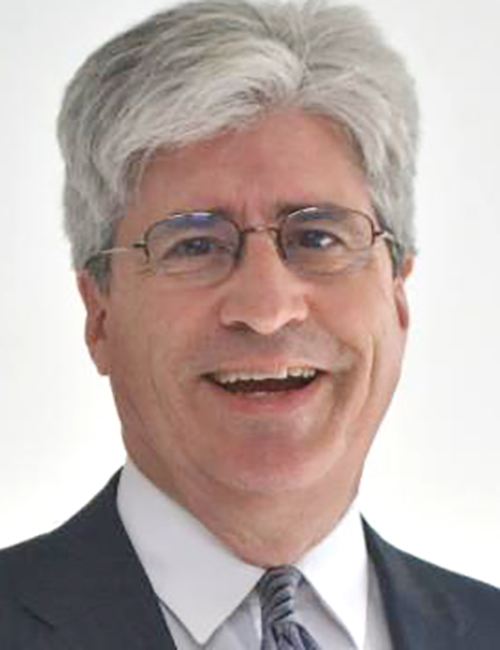
Dear Boardwise: What are ways that our board can establish governance agreements and honor them to hold ourselves accountable?
Monika: Governance agreements are structures that fortify each local educational agency’s ongoing game plan, which invariably includes long-term planning, sharing of team members’ values, striving to work well with administrators and working to cement trust with board colleagues. As individuals, we didn’t all grow up at the same table, meaning our backgrounds vary and make us unique. But we are all at the board table for the same reason: to continuously improve conditions for achievement for the students we serve.
csba at issue
he Research on Lowering Violence in Schools and Communities (ReSOLV) study has released results from its nine-year investigation of the associations between school safety and student outcomes with community and school-based risk and protective factors.
- Help schools understand how risk and need factors in the community influence student engagement and outcomes in school, while helping community leaders understand how violence prevention efforts in the community may benefit educational outcomes for youth, which in turn can prevent future violence.
- Provide insights on building the readiness for individuals, organizations and the broader community to work together to address violence and safety issues using inclusive, equitable and comprehensive strategies that are rooted in evidence of effectiveness.
Researchers hypothesized that schools operate within a broader ecological framework and that risk factors in the community can negatively affect student and school outcomes if schools are not actively working to recognize and mitigate these influences.
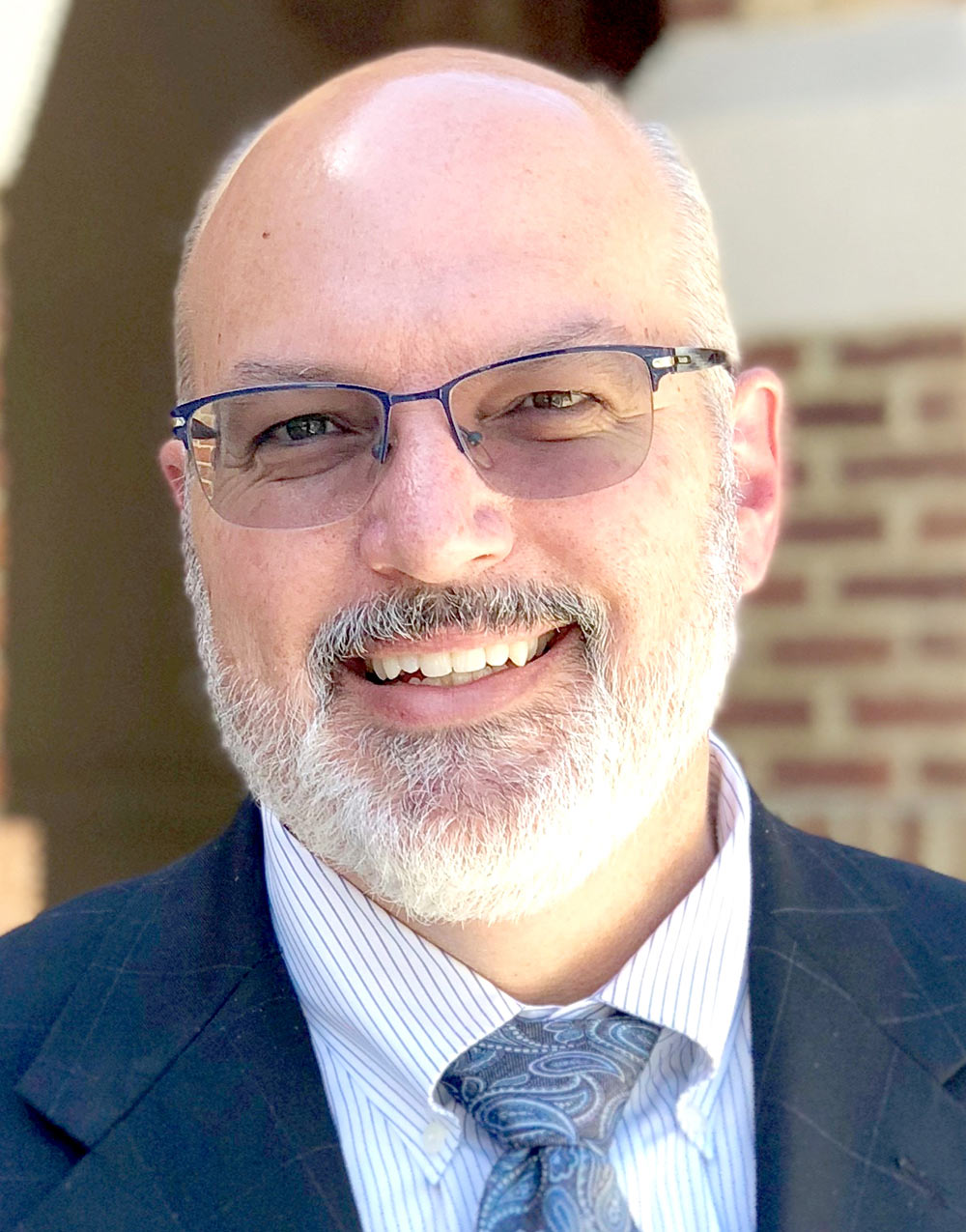
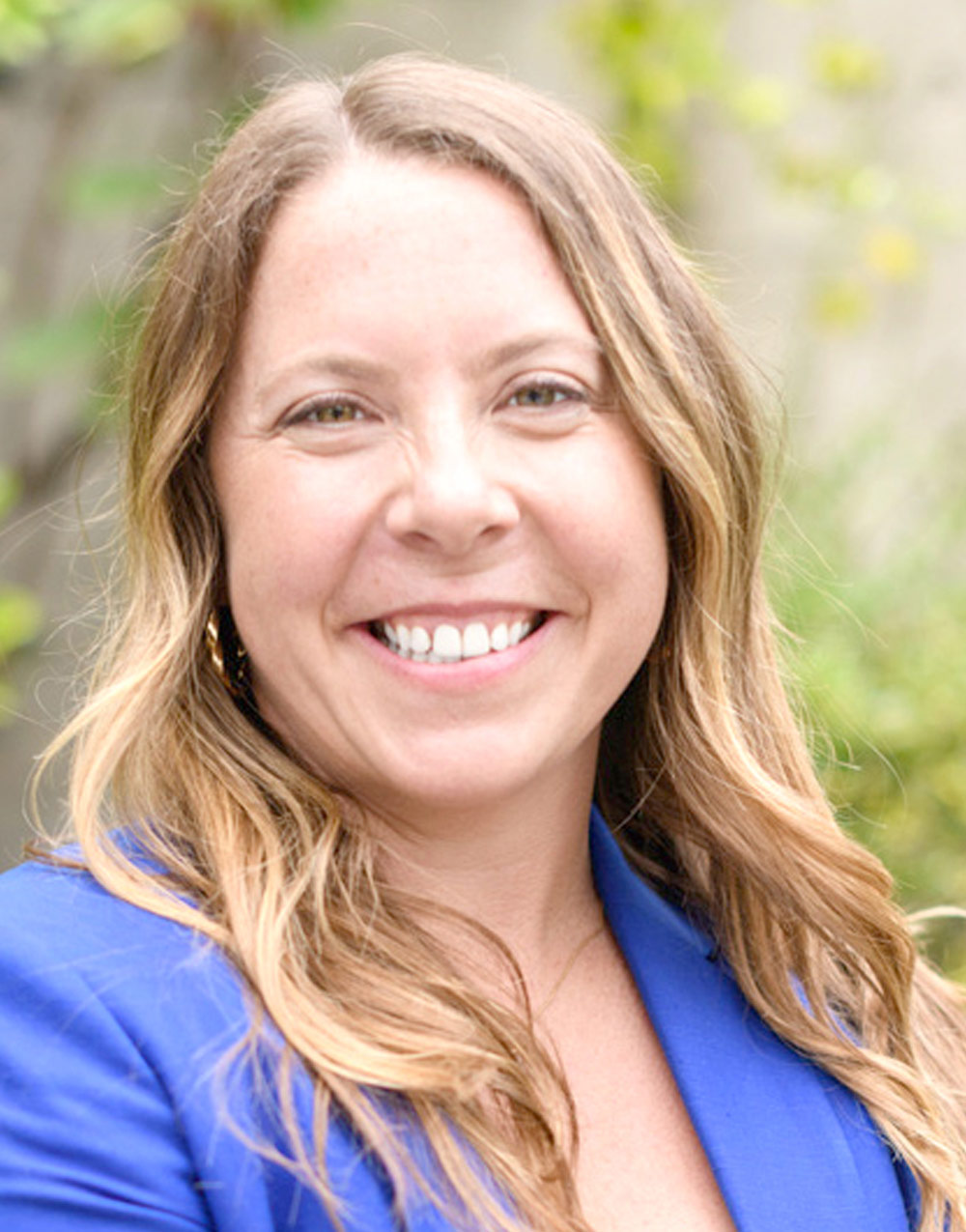
from the field
alifornia has invested in an unprecedented expansion of expanded learning programs (after-school and summer), recognizing the academic, enrichment and social benefits these programs can play in students’ lives. Through the Expanded Learning Opportunities Program (ELO-P), California invests $4 billion annually in after-school and summer programs, with the goal of universal access for elementary school students by 2025.
Not only have we seen the toll that the pandemic has taken on teen learning loss, attendance and mental health, but adolescent brains are developing more significantly than at any time since early childhood. It is also a time when teens are growing intellectually, socially and emotionally. Adolescents need supports and opportunities not just in the traditional school day, but also out of school, including the mentoring relationships, college and career exposure, leadership development and skill building that school- and community-based expanded learning programs provide.

Bridging
the gap
How career technical education unites job training and academics


Shutting
Doors,
Opening
Dialogue:
School closure guidance and best practices for LEAs
by Heather Kemp
tudents file out of classrooms after the final bell rings. It’s the end of the day and they shuffle to their parents’ cars or the school bus to catch a ride home or to an extracurricular activity or job. Others make their way off campus alone or with friends or siblings to their next destination.
Shutting
Doors,
Opening
Dialogue:

tudents file out of classrooms after the final bell rings. It’s the end of the day and they shuffle to their parents’ cars or the school bus to catch a ride home or to an extracurricular activity or job. Others make their way off campus alone or with friends or siblings to their next destination.
Advertorial
n the ever-evolving landscape of education, a notable transition toward differentiated learning is reshaping educators’ approaches to teaching. Acknowledging the individuality of each student—spanning diverse learning styles, interests, and abilities— educators are embracing inventive approaches to provide a tailored and engaging classroom experience.
newcomer
students

anguage wasn’t Tanya Kravchuk’s primary challenge as a newcomer student starting her educational journey in the United States — rather, it was the cultural differences that regularly created uncomfortable situations with teachers and peers.

your legislators voted on CSBA’s priority legislation.
A significant number of bills considered this year affect education and necessitate a look at how your legislators voted on critical bills impacting LEAs, boards of education and the students they serve.
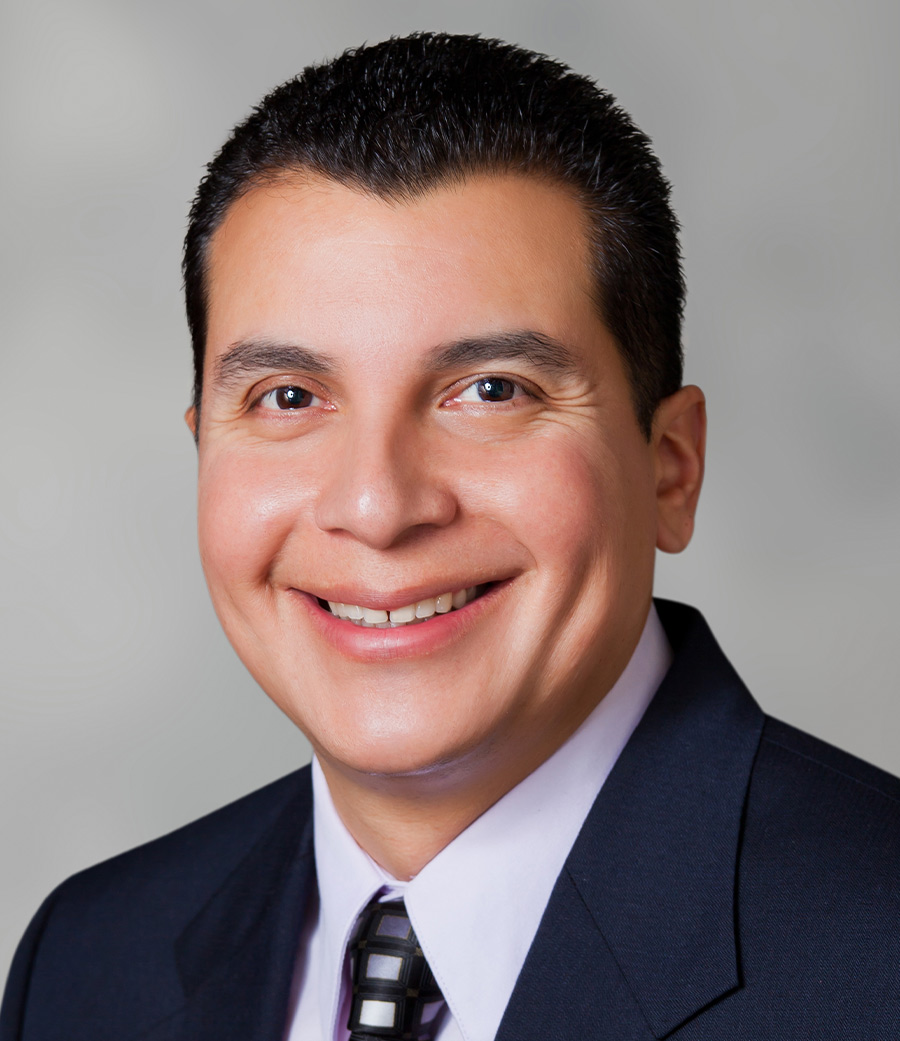

THANK YOU
BuyBoard
Carahsoft Technology Corp.
Crisp Imaging
CSBA Legal Services
Dale Scott & Company
DFA Actuaries
LexisNexis
LifeWings Peak Performance
McPherson & Jacobson LLC
Myers Stevens & Toohey (MST)
Orrick, Herrington, & Sutcliffe LLP
PARS
Piper Sandler
Redistricting Partners

Thanks for reading our Winter 2024 issue!


